Inside\Within is a constantly updating web archive devoted to physically exploring the creative spaces of Chicago's emerging and established artists.
Support for this project was provided by The Propeller Fund, a joint administrated grant from Threewalls and Gallery 400 at The University of Illinois at Chicago.

Search using the field below:
Or display posts from these tags:
3D printing 3D scanning 65 Grand 7/3 Split 8550 Ohio 96 ACRES A+D Gallery ACRE animation Art Institute of Chicago Arts Incubator Arts of Life audio blogging Brain Frame CAKE Carrie Secrist Gallery casting ceramics Chicago Artist Writers Chicago Artists Coalition Chicago Cultural Center Cleve Carney Art Gallery Clutch Gallery Cobalt Studio Coco River Fudge Street collage collection Columbia College Chicago Comfort Station comics conceptual art Contemporary Art Daily Corbett vs. Dempsey Creative Capital DCASE DePaul University design Devening Projects digital art Dock 6 Document drawing Duke University dye Elmhurst Art Museum EXPO Chicago Faber&Faber fashion fiber Field Museum film found objects GIF Graham Foundation graphic design Harold Washington College Hatch Hyde Park Art Center illustration Image File Press Imagists Important Projects ink installation International Museum of Surgical Science Iran Jane-Addams Hull House Museum jewelry Joan Flasch Artist's Book Collection Johalla Projects Julius Caesar Kavi Gupta Links Hall Lloyd Dobler LVL3 Mana Contemporary metalwork Millennium Park Minneapolis College of Art and Design Monique Meloche Museum of Contemporary Art Chicago (MCA) Museum of Contemporary Art Detroit (MOCAD) Museum of Contemporary Photography (MoCP) National Museum of Mexican Art (NMMA) National Resources Defense Council New Capital Northeastern Illinois University Northwestern University Ox-Bow painting paper mache Peanut Gallery peformance Peregrine Program performance photography PLHK poetry portraiture printmaking public art Public Collectors publications Renaissance Society risograph rituals Roman Susan Roots&Culture SAIC screen printing sculpture Sector 2337 Shane Campbell Silver Galleon Press Skowhegan Slow Smart Museum Soberscove Press social practice South of the Tracks Storefront SUB-MISSION Tan n' Loose Temporary Services Terrain Terrain Biennial text-based textile textiles The Banff Centre The Bindery Projects The Cultural Center The Franklin The Hills The Luminary The Packing Plant The Poetry Foundation The Poor Farm The School of the Art Institute of Chicago (SAIC) Threewalls Tracers Trinity College Trubble Club University of Chicago University of Illinois at Chicago (UIC) University of South Florida at Tampa Valerie Carberry Vermont Studio Center video weaving Western Exhibitions wood carving woodwork Yellow Book Yollocalli Arts Reach zinesInside\Within is produced in Chicago, IL.
Get in touch:
contactinsidewithin@gmail.com
Anna Kunz's Methods for Non-Containment
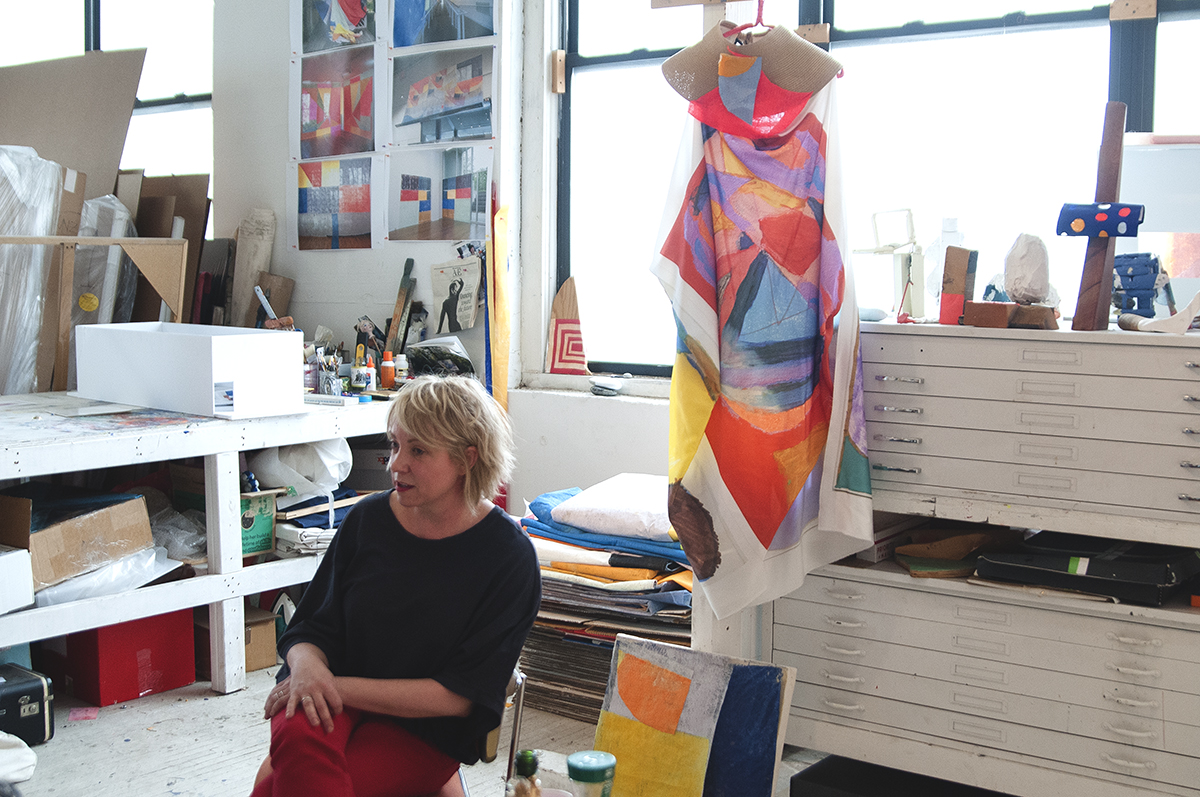
Anna traverses the span of her paintings by using a thick wooden plank, the tool serving as both a unit of measurement and a stage on which to produce her architecturally-scaled works. By organizing specific colors she creates a continuum that moves from canvas to space, a choreography that implicates any work she chooses to place in its proximity. In addition to her large works on canvas, Anna also creates site-specific paintings that formalize light, ephemeral works that change with the shifting sun.
I\W: How do you think your works function in a contemporary society that is saturated in this need for immediate satisfaction and information?
AK: I work in a lot of ways, from paper and sculptures to these more ephemeral paintings that require an element of natural light. I also make paintings on canvas. Because of the way I use color and material to try and formalize this element of light, and I work in a large, more architectural scale, I require your bodily presence in order to really get the point of the work—your figure to my ground. The paintings require a presence for me to make, and for the viewer to really experience in time. I think it’s not an immediate, all at once, viewing. It’s true that there is a moment in culture now where we are receiving visual information at such a rapid pace, there is such a bombardment of mass media images. Painting is so porous, it is capable of absorbing and reordering many things. It is almost counter to that everyday viewing experience. I respond to this immediate satisfaction moment subconsciously, but I intuitively feel like I’m counter reacting to it by making things more tactile and physical. I feel like from teaching, students are dying to get their hands in the mud and have a more tactile response. I am also trying to include sensory engagement in the work that I do, even in the static paintings, so they are less quick to reveal. You have to find a way to relate to it and travel through it with your body.
There is a camera persona to this work. They lend themselves to photography really well. They are not the same painting on Instagram or Facebook as they are in the studio, but I don’t think I mind the presence they have on those formats. There is something that is happening with that shift in scale that is interesting to me. Going from the little rectangle on the device with the thumb to the expanded relationship with the body in real life is something I’m thinking about.
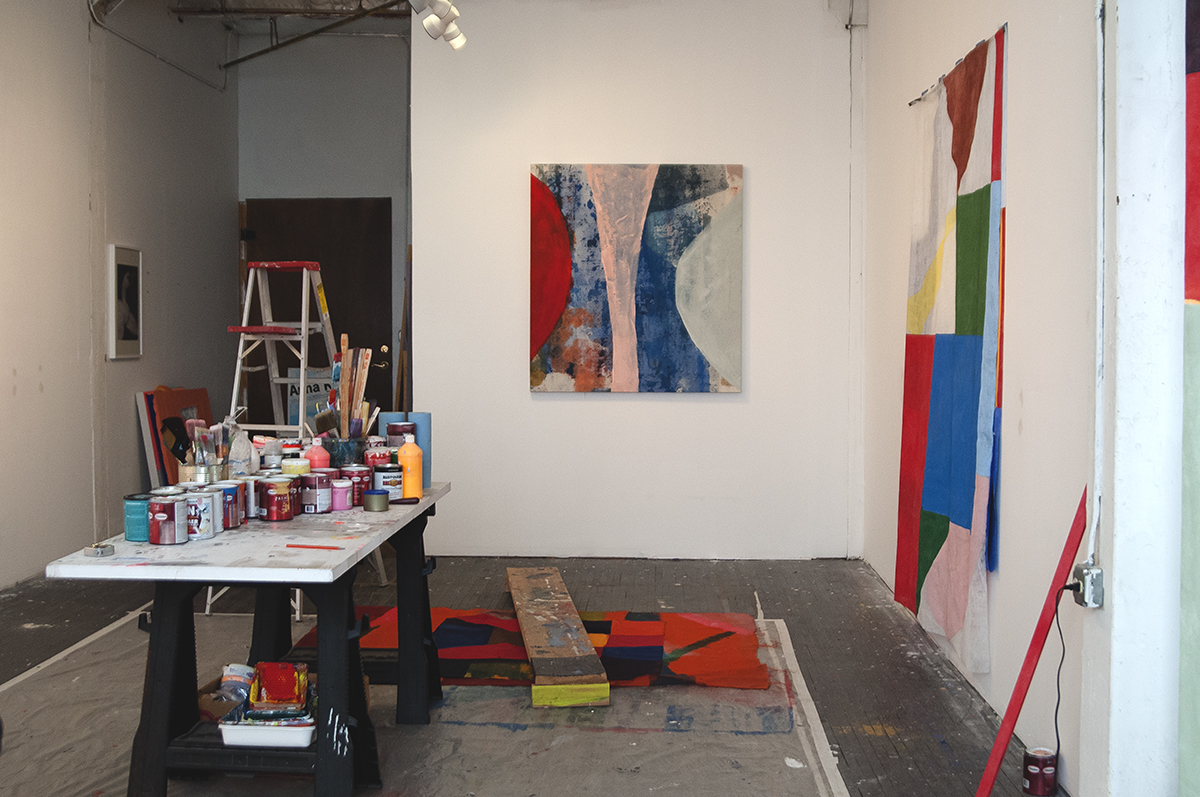
It feels as if the documentation is an extension of the work, similar to your installations. Do you think about the documentation of your work as you are creating it?
I don’t think about documentation of the work, but when I arrange the work in space, I do think about the sightlines and relationships. We are automatically wired with the rectangle in mind at this point because we spend so much time viewing through screens. When asked where I show my work, I joke Facebook. It is the best gallery ever. It is there 24/7, and they are more than happy to show more work. No language needed. Outside of my studio, I use the digital format to review my work and make additions and changes. I think all artists do that at this point. I use it in the process, and think of it as a mini studio. It is great to be able to look at your work on the train or in the line for the dentist. That idea of the mediation of the technology is very helpful because it forces me to think about things differently, or gives me a new chance encounter to deal with that I hadn’t previously thought of. I can turn the work upside down without having to kill myself on a ladder because my work is incredibly physical. It is a really useful tool in that way.
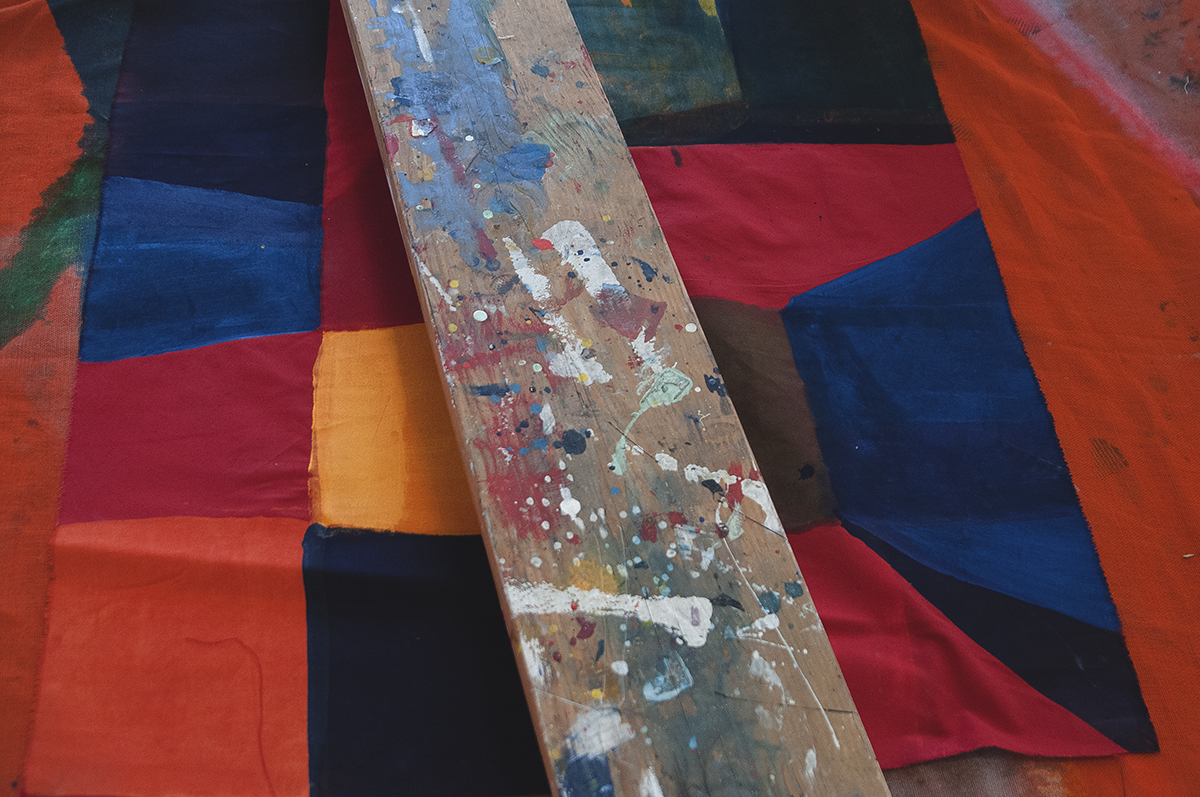
How do you feel like you incorporate choreography into the production of the work?
That plank that is positioned above my canvas is my most important tool because I can sit on it and can move it over my work, like a stage. I can sit over the work and get aerial views and be immersed in the painting. I can be in it. I have no idea what it is going to look like all around at first, but I make the work so it could hang in any direction. The movements are made to encompass volumetric space. It isn’t exactly like action painting, because I am making direct movements and then answering that with another variously paced movement. I place colors to pull the eye through the work. I’m thinking about associations, interweaving things as I work horizontally. Sometimes, it’s comical. I am touching and feeling my way through it, and I move and measure. I use the ‘stage’ as a tool for measurement and other things. There is a performative aspect of that, I can change my orientation of my body to the work. My body is fully engaged when I am making paintings, and I trust that. Dancers have muscle memory when they practice. I am pretty sure through all of the time I have been painting that there is some muscle memory to this vocabulary. The size of the canvas is related to the dimensions of my body. The one there is my wingspan.
Thinking about the idea of choreography as it relates to color, there are many dimensions of color that I think about. One is physiological, one is formal, another one is psychological. This idea of relativity of color it all about how color changes when you put something next to it. So immediately there is one move in color that is answered by another move. So we understand the idea of how movement is imbedded in this idea of choreography and space, but it is also imbedded in how I construct work, or how that movement might then occur in another painting in the room. Also how the works themselves are arranged in a space overall. I think about how they are presented together as a singular work.
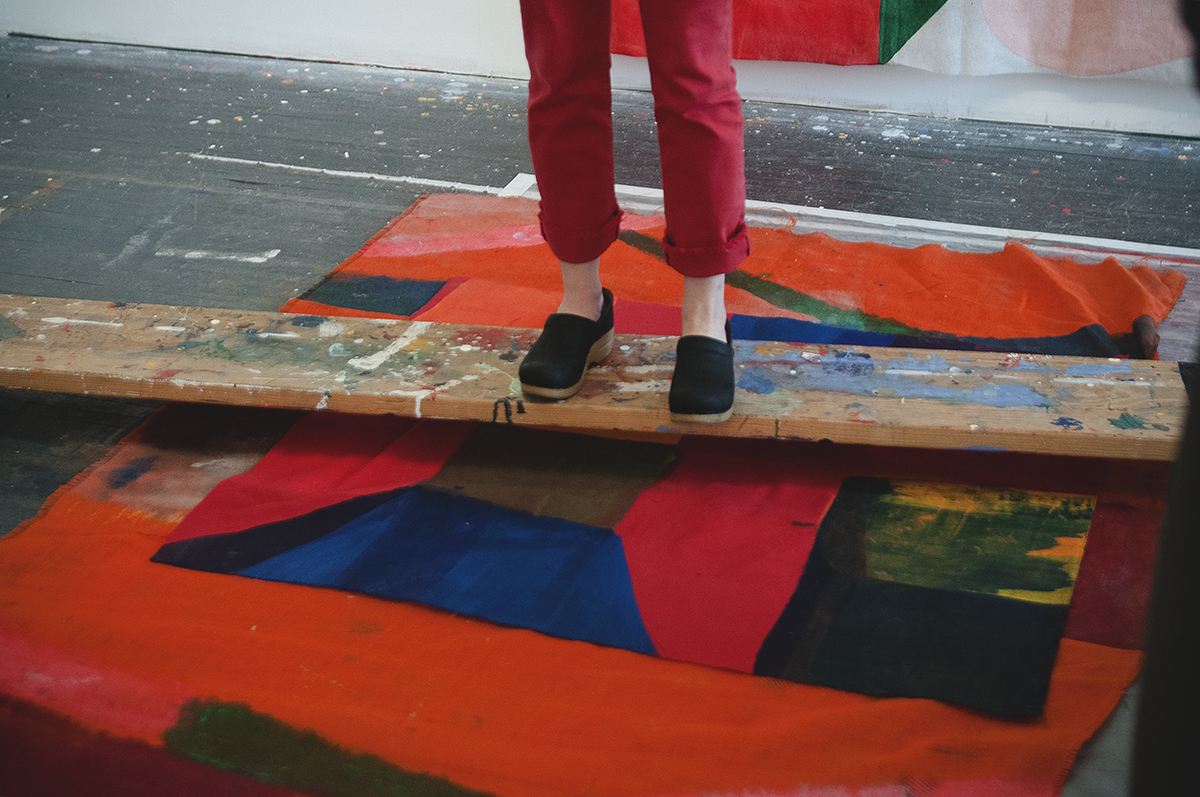
How do you move your pieces outside of the traditional rectangle?
There is this whole idea of the color I orchestrate to create a series of relationships in a continuum. I am not so interested in containment. The only way I could figure out how to move from the picture plane out into space and really try to pursue this idea in painting was to primarily use the element of color because it moves from surface to space, and I can direct it that way. I am still close to painting and the origin of painting being a window into an illusionary space. That will always be fascinating to me, and it still sustains me. I also implicate daylight and the viewer, time and physicality. So this idea of painting invites multiple legibilities (readings), and multiple entrance points. The way I can create continuity within all of that is to organize color in a way that moves within the space. I am not being random about it, I am being specific. I was really interested to read about the choreographic process in dance, and think about Merce Cunningham and Martha Graham, etc. It seemed to satisfy what I was doing as a painter more than academic theory. I learned about painting by experiencing things visually before I ever learned how to think about them through theory or anything academic. Then I had this great opportunity where I could work with dancers and I could learn from them. It goes along with what I have been saying about the performative nature of the work and thinking through the body and trusting it as just as legitimate as any other way of making a painting.
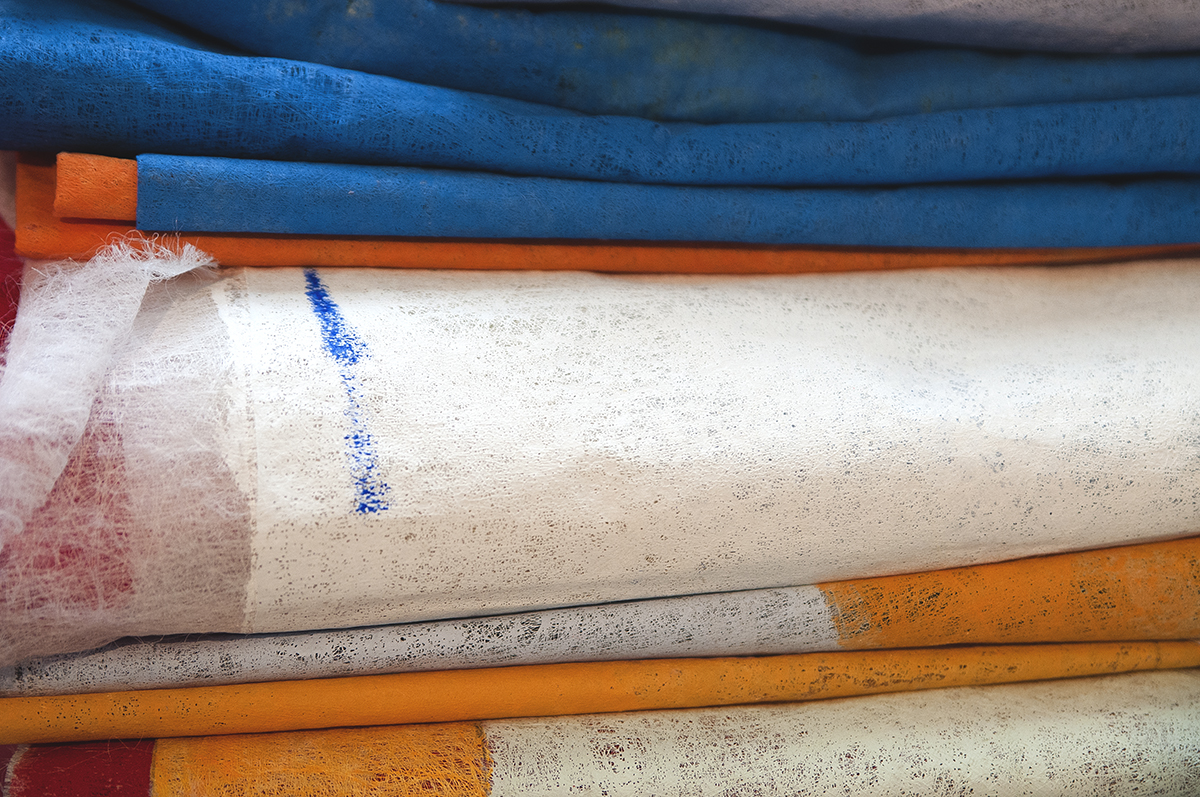
How did your work translate to the stage?
I have a friend who is a classically trained ballet dancer who looks at the intersections between ballet and hip hop and she asked me to do a piece for her. I made a very large painting suspended as a curtain. The materials I used were plastic and tape. I was trying to be resourceful because I was broke and this was a very large, maybe 90-foot situation with no budget. The composition in my piece had some echos and overlaps with the sequences of movement she was performing. Then Carrie Hansen, who has a company called The Seldoms, asked if I would collaborate with her company so I did this piece, a giant, moveable cardboard box piece. She was looking into the multifaceted arguments surrounding global warming, so I translated some ideas materially and with color. I studied the automotive industry and figured out automotive color and how to create transitions in the colors to go from automotives to human beings, to a state of alarm. I could transition one color association to another, from cars to all of these different flesh tones. I was able to do all of that with theatrical lighting.

Do you feel as if your work changed when you took it back from the stage?
No because nothing was start and stop.I studied performance and printmaking and I realize that both forms are about trying to create an impression or take something from one surface or space to another. In print, it’s the possibility of moving information from one plane to another, and in performance, a reverberation of feeling to the viewer. I enjoy thinking about the transfer or exchange. In the studio, I have just been making more theatrical work alongside the other studio work simultaneously. I gained a deeper understanding about scale and really seeing body movement, proportions, and getting different ideas for composition. I was pleased to do the collaborative work for the stage because it fit with my interests in painting. The stage provided a new context for my paintings. I could think about it as a way to feed the other work because of my ideas of non-containment and obviously ideas of theatricality. “The canvas is an arena with which to act,” is what Jackson Pollock said, and I can relate to that.
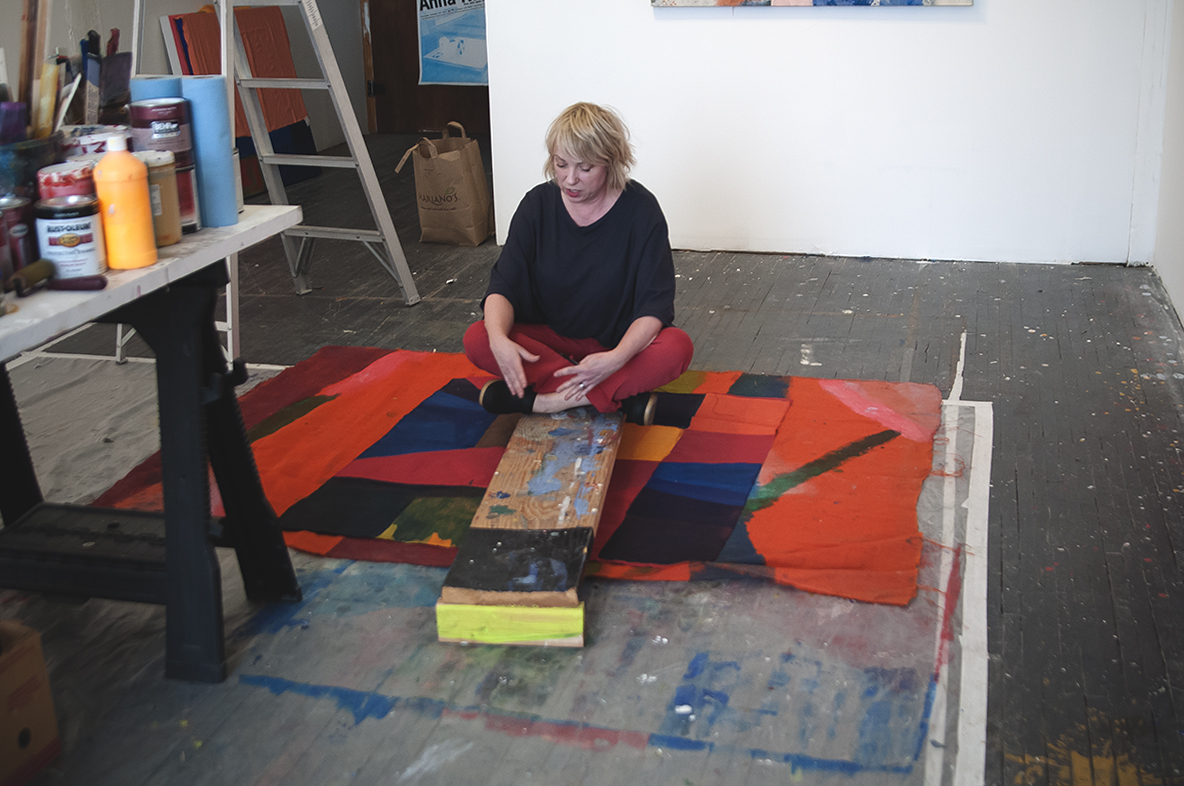
What is the process you use to imbue color into the walls of an exhibition space you are showing within?
I take a particular fabric, which is important to me because it is a non-woven fiber, meaning it is a chaotic ground, and not a grid. Then I look at the given conditions of the architecture. I don’t want the wall to be a passive participant. I take careful time placing the fiber, then I take the paint, and I figure out the color and look at what happens with the natural or artificial light source. Then I penetrate the paint through the wall to register to the wall in a primitive means of transfer. What I am doing is creating an illusion and a transfer. The wall is stable, and painted in a transparent way so you don’t know if it is a painting or a wall. The skin that I pull from the face in the painting is then suspended from another part and the daylight can come through it. My viewer’s body interacts with all of this and is confronted with this idea of opacity and transparency and illusion. The opacity depends on the daylight, so it deals with the performance of the world. That’s where time is involved as well with your first question of immediacy, the painting changes every second.
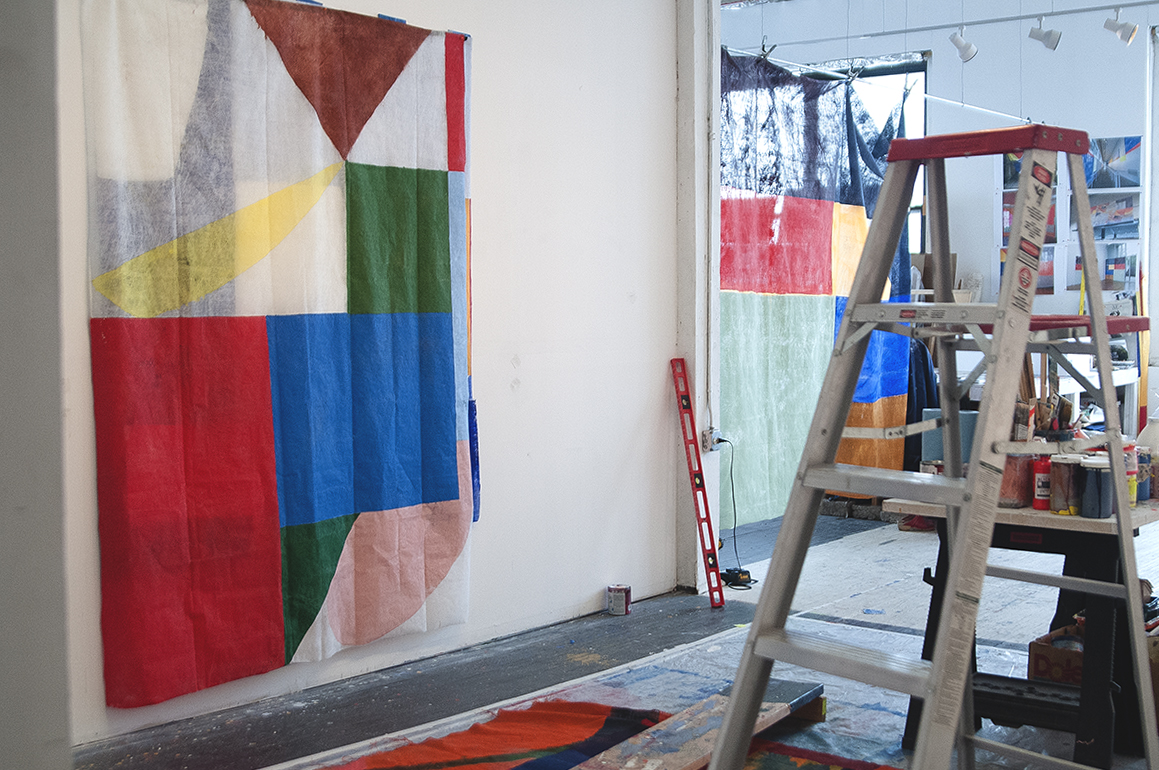
At the root, the work is based in sensation, understanding, and owning the power of one’s intuition. Then also finding a way to present the work so that the viewer feels included in the experience.
The painting on the wall is in reality the negative, but it becomes the fully formed object.
The physical versus the illusionary. The suspended paintings are part of my work but they are not the whole. I’m interested in working through the surface in that work, within the surface in the porous paintings and on the surface in the sculptures. They share the same space when I position them together in adjacent relationships. Even though I cull things from different worlds, they are all related. At the root, the work is based in sensation, understanding, and owning the power of one’s intuition. Then also finding a way to present the work so that the viewer feels included in the experience.
Do you start with color or shape first?
Color, always.


